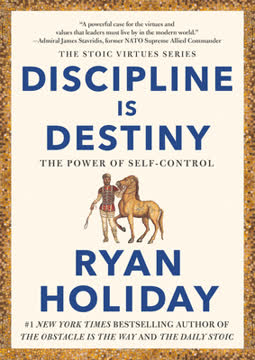Key Takeaways
1. Resilience is the capacity to adapt and thrive amid disruption
If we cannot control the volatile tides of change, we can learn to build better boats.
Definition of resilience. Resilience is the ability of a system, enterprise, or person to maintain its core purpose and integrity in the face of dramatically changed circumstances. It's not about avoiding disruptions, but about having the capacity to absorb shocks, adapt, and even transform when necessary.
Key aspects of resilience:
- Continuity: Maintaining essential functions and identity
- Recovery: Bouncing back from disturbances
- Adaptation: Evolving to better fit new conditions
- Transformation: Fundamentally changing when required
Resilience thinking encourages us to design organizations, institutions, and systems that can absorb disruption, operate under varied conditions, and shift fluidly between circumstances. This approach is crucial in our increasingly volatile and interconnected world, where disruptions in one area can rapidly cascade into others.
2. Complex systems are often robust yet fragile
All RYF systems involve critical trade-offs, between efficiency and fragility on the one hand and inefficiency and robustness on the other.
Robust Yet Fragile (RYF) phenomenon. Many complex systems, from ecosystems to financial markets, exhibit a paradoxical nature: they are highly resistant to anticipated disruptions but extremely vulnerable to unexpected ones. This RYF characteristic stems from the optimization of systems to handle common challenges, which can inadvertently create fragilities to rare, unforeseen events.
Examples of RYF systems:
- Internet: Robust to random failures, vulnerable to targeted attacks
- Human immune system: Resilient to most pathogens, susceptible to novel viruses
- Financial markets: Stable under normal conditions, prone to cascading failures
Understanding the RYF nature of systems is crucial for building true resilience. It requires balancing efficiency with redundancy, and specialized capabilities with general adaptability. Recognizing potential fragilities allows for the development of compensatory mechanisms and diverse response strategies.
3. Diversity and modularity enhance systemic resilience
Nature has had 3.8 billion years of experience at getting multiple benefits from single expenditures: Willie's work is the extraordinary example of modeling nature and creating this same abundance by design.
Biodiversity as a model. Natural ecosystems demonstrate how diversity and modularity contribute to resilience. In a healthy ecosystem, multiple species can perform similar functions, providing redundancy and adaptability. This principle can be applied to human-designed systems to enhance their resilience.
Key strategies for building resilience:
- Diversification: Maintaining variety in components and approaches
- Modularity: Creating independent, interconnected subsystems
- Redundancy: Building in backup capabilities and resources
- Decoupling: Allowing parts of the system to operate independently
These strategies help systems absorb shocks, adapt to changes, and maintain core functions even when some components fail. For example, a diverse energy grid with multiple sources and distributed generation is more resilient than one relying on a single, centralized power plant.
4. Sensing, scaling, and swarming enable adaptive responses
The grid needs vastly more sensors deployed at every level of its organization, from the core to the periphery.
Adaptive capabilities. Resilient systems possess three key abilities that allow them to respond effectively to disruptions:
- Sensing: Detecting changes and potential threats early
- Scaling: Adjusting the level of activity and resource allocation
- Swarming: Coordinating distributed responses to challenges
These capabilities enable systems to:
- Anticipate problems before they become critical
- Conserve resources during periods of low stress
- Rapidly mobilize when faced with threats
- Self-organize effective responses without centralized control
Examples of these capabilities in action include:
- Smart power grids that can detect and isolate failures
- Terrorist networks that can lie dormant and then rapidly mobilize
- Distributed disaster response efforts like the Haiti earthquake mapping project
Developing these adaptive capabilities in human systems often requires leveraging technology, fostering decentralized decision-making, and creating flexible organizational structures.
5. Clustered diversity fosters innovation and resilience
Cities seem to open up: the spectrum of functionalities, job opportunities, connections, etc. That is key to the vitality and the buzz of successful cities.
Power of urban environments. Cities exemplify how clustered diversity drives innovation and resilience. The density and variety of people, ideas, and resources in urban areas create a fertile environment for creativity and adaptation.
Characteristics of resilient clusters:
- Density: High concentration of diverse elements
- Connectivity: Rich networks of relationships and information flows
- Diversity: Wide range of skills, perspectives, and resources
- Dynamism: Constant interaction and recombination of ideas
These principles can be applied beyond cities to other systems, such as business ecosystems or research communities. By fostering environments that bring together diverse elements in close proximity, we can enhance the adaptive capacity and innovative potential of organizations and societies.
6. Personal resilience stems from mindset and social connections
Our resilience is rooted not only in our beliefs and values, in our character, experiences, values, and genes, but critically in our habits of mind—habits we can cultivate and change.
Cultivating individual resilience. Personal resilience is not just an innate trait but a set of skills and mindsets that can be developed. Key factors contributing to individual resilience include:
- Positive outlook and cognitive flexibility
- Strong social support networks
- Sense of purpose and meaning
- Ability to regulate emotions
- Physical health and self-care practices
Research has shown that practices like mindfulness meditation can significantly enhance personal resilience by improving emotional regulation, reducing stress, and fostering a more adaptive mindset. Additionally, maintaining strong social connections provides crucial support during challenging times.
7. Cooperation and trust underpin community resilience
To achieve a truly wise crowd with accurate predictive skills, you either need to have an extremely smart crowd (high ability) or you need to have people who are moderately smart but who also happen to be cognitively diverse (high diversity).
Building collaborative capacity. The ability of communities to cooperate effectively in the face of challenges is a critical component of resilience. Trust and social capital are essential foundations for this cooperation.
Strategies for fostering community resilience:
- Develop shared goals and values
- Create opportunities for meaningful interaction
- Build inclusive decision-making processes
- Establish clear communication channels
- Recognize and leverage diverse skills and resources
Examples like the CeaseFire violence prevention program in Chicago demonstrate how community-based interventions can build trust, change social norms, and enhance collective resilience to complex problems.
8. Cognitive diversity improves group decision-making and adaptability
With the right amount of diversity, the volume, speed, and revenue generated by the work all went up.
Benefits of diverse thinking. Groups with diverse cognitive styles and perspectives are better equipped to solve complex problems and adapt to changing circumstances. This cognitive diversity goes beyond demographic diversity to include differences in thinking styles, expertise, and problem-solving approaches.
Ways to enhance cognitive diversity:
- Recruit team members with varied backgrounds and skills
- Encourage dissenting opinions and constructive debate
- Rotate roles and responsibilities
- Expose teams to different environments and challenges
- Use tools like Red Teaming to systematically challenge assumptions
Organizations that cultivate cognitive diversity are more likely to identify potential risks, generate innovative solutions, and adapt successfully to disruptions.
9. Effective interventions require community engagement
In a healthy network, you have to connect on your similarities and compete on your differences.
Importance of local involvement. Interventions aimed at enhancing resilience are most effective when they engage deeply with the communities they aim to serve. Top-down approaches often fail to account for local contexts, values, and capabilities.
Principles for community-engaged interventions:
- Involve local stakeholders in planning and implementation
- Build on existing community strengths and resources
- Respect and incorporate local knowledge and practices
- Foster local ownership and leadership
- Adapt strategies to fit local contexts
The contrast between the failed well-painting intervention in Bangladesh and the successful CeaseFire program in Chicago illustrates the importance of genuine community engagement in designing and implementing resilience-building initiatives.
10. Translational leaders bridge divides and foster adaptation
Other people offer solutions, while I offer dialogues. When I work with people, we discuss and we discuss and I let them think and then we discuss some more.
Role of bridging leadership. Translational leaders play a crucial role in building resilience by connecting diverse groups, facilitating communication across boundaries, and fostering adaptive responses to challenges. These leaders act as bridges between different constituencies, levels of organization, and ways of thinking.
Characteristics of translational leaders:
- Cultural fluency and ability to navigate diverse contexts
- Skill in facilitating dialogue and building trust
- Capacity to translate between different perspectives and knowledge systems
- Ability to identify and leverage diverse resources and capabilities
- Commitment to long-term relationship building
The work of Noah Idechong in Palau exemplifies how translational leaders can integrate traditional knowledge with modern scientific approaches, bridging cultural divides to enhance environmental and community resilience.
Last updated:
FAQ
1. What’s Resilience: Why Things Bounce Back by Andrew Zolli about?
- Exploration of resilience: The book examines resilience as the ability of systems—ranging from ecosystems and economies to individuals and communities—to absorb shocks, adapt, and continue functioning amid disruption.
- Interconnected systems: Zolli uses real-world examples, such as the 2007 tortilla riots and coral reef collapses, to illustrate how complex interdependencies can lead to unexpected crises.
- Interdisciplinary approach: Insights from ecology, neuroscience, economics, and social science are woven together to reveal universal patterns and principles of resilience.
- Focus on social resilience: A significant portion of the book is dedicated to how communities and networks can build adaptive capacity to respond to crises.
2. Why should I read Resilience: Why Things Bounce Back by Andrew Zolli?
- Understanding complexity: The book provides a framework for making sense of the volatility and interconnectedness of modern life, from financial crises to natural disasters.
- Practical strategies: Zolli offers actionable advice for building resilience at personal, organizational, and community levels, making it relevant for leaders, policymakers, and individuals.
- Real-world case studies: Examples like Mission 4636 in Haiti and Chicago’s CeaseFire program show how resilience strategies work in practice.
- Holistic perspective: The book bridges disciplines, offering insights that apply to business, environment, and society.
3. What are the key takeaways from Resilience: Why Things Bounce Back by Andrew Zolli?
- Resilience is dynamic: Systems must continuously adapt, reorganize, and evolve rather than simply return to a previous state after disruption.
- Patterns of resilience: Key principles include feedback loops, modularity, diversity, and dynamic reorganization, which help systems absorb shocks.
- Social factors matter: Trust, cooperation, cognitive diversity, and strong communities are essential for social resilience.
- Leadership and networks: Translational leaders and network weaving are crucial for fostering adaptive capacity and coordinated responses.
4. How does Andrew Zolli define resilience in Resilience: Why Things Bounce Back, and how is it different from robustness or redundancy?
- Resilience vs. robustness: Robustness is about withstanding shocks without change, while resilience includes the ability to recover, adapt, and reorganize after disruption.
- Resilience vs. redundancy: Redundancy involves having backups, but resilience is broader, encompassing flexibility and transformation in response to change.
- Dynamic adaptation: Resilient systems may not return to their original state but instead evolve to meet new circumstances.
- Ongoing process: Resilience is seen as a continuous journey, not a fixed state.
5. What are the main concepts and patterns of resilience discussed in Resilience: Why Things Bounce Back by Andrew Zolli?
- Robust-yet-fragile systems: Systems optimized for efficiency can be robust to expected disturbances but fragile to unexpected shocks, as seen in financial markets and the Internet.
- Adaptive cycle: Zolli introduces the cycle of growth, conservation, release, and reorganization, explaining how systems naturally fluctuate.
- Feedback loops and modularity: Tight feedback mechanisms and modular structures help systems detect problems early and isolate failures.
- Diversity and clustering: Cognitive and resource diversity, along with dense clusters, enhance resilience by providing more options for adaptation.
6. What real-world examples does Andrew Zolli use in Resilience: Why Things Bounce Back to illustrate resilience and fragility?
- Tortilla riots and Hurricane Katrina: These events show how interconnected systems—energy, agriculture, and trade—can trigger social unrest.
- Jamaica’s coral reef collapse: Demonstrates how loss of biodiversity and overfishing led to a fragile ecosystem flipping to algae dominance.
- Mission 4636 in Haiti: Highlights how crowdsourced crisis mapping and global volunteer networks provided rapid disaster response.
- CeaseFire in Chicago: Illustrates treating violence as a contagious disease and using community members to interrupt cycles of retaliation.
7. How does Resilience: Why Things Bounce Back by Andrew Zolli explain the role of trust, cooperation, and social networks in resilience?
- Neurobiology of trust: Oxytocin increases willingness to accept social risks and cooperate, but can also reinforce in-group biases.
- Game theory insights: Strategies like Tit for Tat and Tit for Two Tats show how cooperation can emerge and be sustained, even in competitive environments.
- Enlarging the tribe: Structured social interactions can reduce prejudice and build trust across group boundaries, facilitating broader cooperation.
- Case studies: The 2008 Lehman Brothers crisis and Mission 4636 demonstrate the importance of trust and cooperation in both failure and success.
8. What is the significance of cognitive diversity and leadership in building resilience, according to Andrew Zolli?
- Cognitive diversity benefits: Teams with diverse perspectives solve problems more effectively and avoid groupthink.
- Red Team University: Training programs that encourage challenging assumptions and thinking like adversaries enhance decision-making and resilience.
- Translational leaders: Leaders who bridge cultural, organizational, and disciplinary divides are essential for weaving adaptive networks.
- Network weaving: Building connections across different groups increases a system’s adaptive capacity.
9. How does Resilience: Why Things Bounce Back by Andrew Zolli address risk, safety, and organizational culture?
- Risk homeostasis theory: People adjust their behavior to maintain a comfortable level of risk, sometimes negating the benefits of safety measures.
- Cultural risk tolerance: Organizations can develop cultures that normalize high-risk decisions, leading to disasters like the Deepwater Horizon spill.
- Building skepticism: Programs that foster critical thinking and challenge complacency are vital for managing risk in complex systems.
- Continuous assessment: Mapping fragilities and feedback loops helps anticipate and prepare for disruptions.
10. What lessons does Andrew Zolli draw from community interventions like CeaseFire and Bangladesh’s arsenic crisis in Resilience: Why Things Bounce Back?
- CeaseFire’s approach: Treating violence as a contagious disease and using trusted community members to interrupt cycles of retaliation can significantly reduce shootings.
- Bangladesh arsenic mitigation: Top-down interventions that ignore cultural norms can fail or have unintended consequences, such as stigma and continued exposure.
- Community engagement: Successful resilience interventions require deep involvement of affected communities and culturally appropriate solutions.
- Adaptive management: Ongoing, flexible approaches are more effective than one-off engineering fixes.
11. How does Andrew Zolli suggest individuals and organizations can apply resilience principles from Resilience: Why Things Bounce Back in daily life?
- Mapping vulnerabilities: Regularly assess and monitor system fragilities and feedback loops to anticipate disruptions.
- Embracing adhocracy: Flexible, decentralized structures empower specialist teams and encourage improvisation, as seen in Mission 4636.
- Leveraging data and rehearsal: Use real-time monitoring, predictive modeling, and scenario rehearsal tools to prepare for future challenges.
- Cultivating habits of mind: Optimism, hardiness, mindfulness, and social support are key traits for personal resilience.
12. What are the best quotes from Resilience: Why Things Bounce Back by Andrew Zolli and what do they mean?
- On altruism and group identity: “Altruism is characterized by strong emotion and protean allegiance. Human beings are consistent in their codes of honor but endlessly fickle with reference to whom the codes apply.” (E.O. Wilson) — Highlights the fluidity of in-group definitions and the potential to expand cooperation.
- On respect in negotiation: “Respect is an interesting element because it’s a positive-sum element. If I give you respect, I don’t have less respect for myself. In fact, you’re likely to give me more.” (William Ury) — Emphasizes respect as a low-cost, high-return strategy for building cooperation.
- On resilience as a journey: “Resilience is always, perhaps maddeningly, provisional... Every effort at resilience buys us not certainty, but another day, another chance. Every day is Day One.” — Captures resilience as an ongoing, dynamic process rather than a fixed state.
- On the challenge of resilience: The book notes that resilience requires ongoing commitment, longer-term thinking, and a willingness to embrace less-than-peak efficiency for greater adaptability.
Review Summary
Resilience received mixed reviews, with an average rating of 3.63 out of 5. Some readers praised its broad scope and thought-provoking ideas on system adaptability, while others found it disjointed and overly academic. Positive reviews highlighted the book's insights on building resilient systems and individuals, diverse examples, and relevance to current issues. Critics felt it lacked focus, contained too many anecdotes, and failed to provide clear guidance. Despite mixed opinions, many readers found value in the book's exploration of resilience across various domains.
Similar Books










Download PDF
Download EPUB
.epub digital book format is ideal for reading ebooks on phones, tablets, and e-readers.




